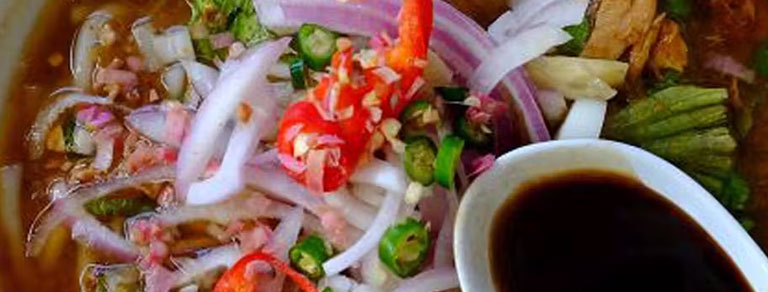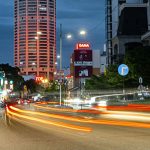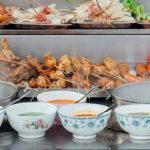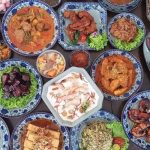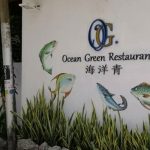Alright, let’s talk about a pilgrimage. Not the kind with temples and incense, but one that involves a winding drive to the “back of the island,” as the locals call Balik Pulau. This is my kind of spiritual journey, friends—a quest for the perfect bowl of laksa. Forget the hip cafes in George Town for a moment; the real soul of Penang’s food scene often whispers from a humble, plastic stool in a sleepy town, and in Balik Pulau, that whisper sounds a lot like the slurping of noodles.
For years, I’ve heard the arguments over kopi O, the passionate debates between friends and family: which laksa in Balik Pulau is the undisputed champion? It’s a topic that can divide households and unite strangers. Is it the legendary, long-standing Penang-style laksa from the heart of the pekan? Or do the rustic, fiery Malay-style bowls hidden in the kampung steal the crown?
I decided it was time to settle it for myself. So, with an empty stomach and an open mind, I embarked on a three-stop laksa showdown. Our contenders: the venerable Kim Laksa in Nan Guang Kopitiam, the wildly popular Laksa Janggus nestled in a village setting, and the up-and-coming Laksa Ikan Sekoq, which throws a whole fish into the mix. This isn’t just about taste; it’s about the vibe, the people, and the story in every bowl. So, grab a drink, pull up a chair, and let’s dive headfirst into the heart of Balik Pulau’s laksa legacy.
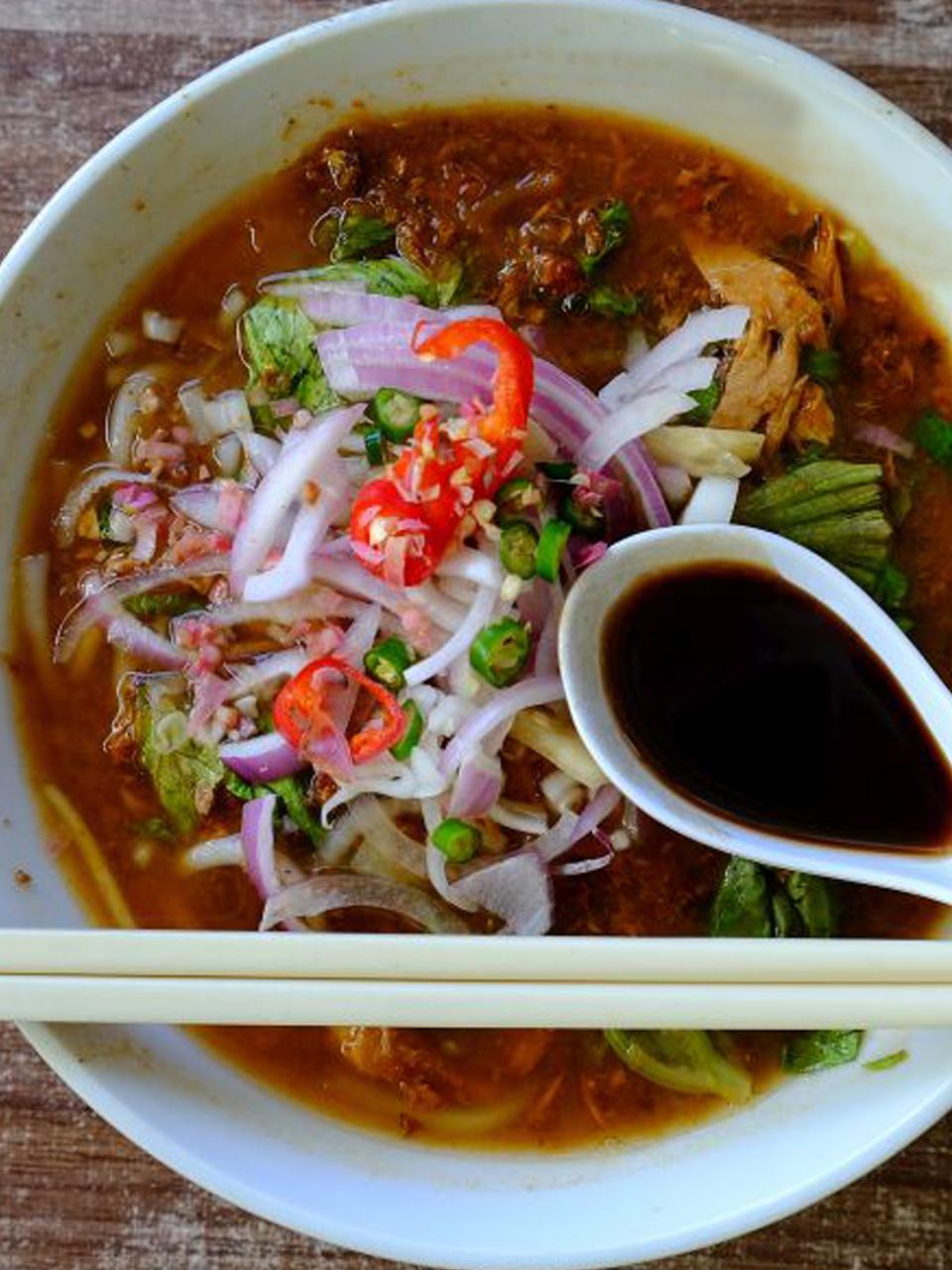
Contender #1: The Old Guard – Kim Laksa at Nan Guang Kopitiam
You can’t talk about Balik Pulau laksa without starting at Kim Laksa. It feels like a rite of passage. Located in the classic Nan Guang Kopitiam, this place is an institution, serving bowls of goodness since the 1940s. Walking into this old-school coffee shop is like stepping back in time. The marble-topped tables, the rhythmic clatter of cups, and the uncles reading their papers—it’s a scene straight out of a Penang postcard. The air is thick with the aroma of roasted coffee and, of course, the unmistakable tangy scent of laksa broth.
Kim Laksa is currently run by the second-generation owner, Christine, who carries on the legacy her mother started. The stall itself is unassuming, tucked into a corner of the bustling kopitiam. But the constant stream of customers tells you you’re in the right place. One of the things that makes Kim Laksa a legend is that they offer two distinct types of laksa: the classic Penang Asam Laksa and the richer, creamier Siam Laksa (often called Laksa Lemak). Can’t decide? You can even ask for a mix of both broths, a little “half and half” adventure in a bowl.
I, of course, had to try both. First up, the Asam Laksa. A small bowl will set you back around RM5.50, with a larger option for a ringgit more—incredibly reasonable for a dish with such a storied history. The bowl that arrived was a work of art: thick, springy lai fun noodles swimming in a vibrant, orange-hued broth, generously topped with shredded cucumber, pineapple, onions, and fresh mint leaves. A dollop of hae ko (fermented shrimp paste) sat regally on top, waiting to be stirred in.
The first spoonful of the broth is a wake-up call for your taste buds. It’s a complex symphony of sour, spicy, and savory. The tang from the tamarind (asam) is pronounced but not overwhelmingly sharp, and it’s beautifully balanced with the sweetness of the pineapple and the deep, umami flavor of the flaked mackerel. What I love about Kim’s Asam Laksa is the generosity of the fish; the broth is thick and hearty with it. Stirring in the hae ko adds another layer of pungent sweetness that brings it all together. It’s a classic for a reason—a truly well-balanced and satisfying bowl. Some, however, might find the noodles a bit too thick and the broth a little on the fishy side.
Next, the Siam Laksa. This one is for those who prefer a creamier, less aggressive flavor profile. The broth is enriched with coconut milk (santan), which gives it a luscious, velvety texture and a pale, inviting color. While it still has a hint of sourness, the coconut milk mellows it out, creating a harmonious blend of sweet, sour, and spice. It’s a comforting, almost soothing bowl of noodles. While I enjoyed it, some might find the Siam Laksa here a bit diluted compared to the punchiness of the Asam Laksa.
The Vibe: Nan Guang Kopitiam is a quintessential Malaysian coffee shop experience. It’s noisy, it’s bustling, and it’s full of life. It’s the kind of place where you share a table with strangers who might just strike up a conversation about the very laksa you’re eating. The friendly, no-nonsense aunties running the show add to the charm.
Must-Try Drink: You absolutely have to order the fresh nutmeg juice with sour plum. It’s the perfect antidote to the heat and the spiciness of the laksa, a true Balik Pulau specialty.
Who’s It Good For? This is a must-visit for first-timers to Balik Pulau and anyone who appreciates a classic, well-executed Asam Laksa. It’s great for solo travelers, families, and anyone looking for an authentic kopitiam experience.
Contender #2: The Kampung Champion – Laksa Janggus
About a ten-minute drive from the town center, nestled in a quiet village called Kampung Perlis (no, not the state!), you’ll find our next contender: Laksa Janggus. This place is a whole different world from the bustling town kopitiam. Here, you’re surrounded by greenery and a laid-back, rural atmosphere. Don’t be surprised if a chicken or two wanders past your table.
Laksa Janggus is a Malay-style laksa, and it’s a self-service affair, which adds to its rustic charm. You queue up at different stations for your laksa, drinks, and a tempting array of fried snacks like pisang goreng (banana fritters). The place gets incredibly busy, especially on weekends, with cars parked all along the narrow country road. It’s a testament to its immense popularity.
The laksa here is noticeably different from Kim’s. The broth is still fish-based but has a distinctly different spice profile. It’s a beautiful, deep red, hinting at the generous use of chili. The flavor is a captivating blend of spicy and sour, with a more pronounced herbaceousness. It’s served with a hard-boiled egg, a common feature in Malay-style laksa that you won’t find in the Chinese version. A bowl of laksa is priced at a very affordable RM8.
What stands out at Laksa Janggus is the perfect harmony of flavors. The spiciness is there, but it’s a warm, lingering heat rather than a sharp burn. The sour notes are present but play a supporting role to the rich, fishy broth. The noodles are smooth and slurpable, and the fresh garnishes of cucumber, onions, and local herbs add a refreshing crunch. It’s a hearty, soulful bowl of laksa that tastes like it’s been simmering for hours with love and care.
One of the highlights of the Laksa Janggus experience is the array of other goodies you can enjoy alongside your noodles. The crispy, golden-brown pisang goreng is a must-try, and washing it all down with a sweet, cold ais kacang makes for a perfect afternoon treat.
The Vibe: It’s a true kampung experience. You’re eating in a simple, open-air setting, surrounded by the sights and sounds of the countryside. It’s relaxed, it’s friendly, and it feels a world away from the city. The self-service system is efficient, and despite the crowds, there’s a sense of communal enjoyment in the air.
Must-Try Side Dish: Don’t even think about leaving without trying the pisang goreng. They are fried to perfection and are the ideal companion to your spicy laksa.
Who’s It Good For? Laksa Janggus is for the adventurous foodie who wants to experience authentic Malay-style laksa in a genuine village setting. It’s perfect for families and groups of friends looking for a casual, delicious, and budget-friendly meal.
Contender #3: The Game Changer – Laksa Ikan Sekoq
Our final contender is a bit of a wildcard, but one that’s been making waves in the Balik Pulau laksa scene: Laksa Ikan Sekoq. The name itself is a giveaway—ikan sekor means “a whole fish” in the local dialect. And that’s exactly what you get: a bowl of laksa with a whole fish lounging in the broth.
Located at Fara Idlan Mini Cafe, just next to the post office, this spot has been gaining a loyal following for its bold and generous take on Malay-style laksa. The stall is simple and unassuming, but the laksa is anything but.
The presentation alone is impressive. The whole, perfectly cooked fish (usually a kembung or mackerel) makes for a very Instagrammable bowl. But this isn’t just a gimmick; the fish is tender and flaky, and having it whole seems to infuse the broth with an extra depth of flavor.
The broth itself is intensely flavorful and spicy. If you’re a fan of bold, fiery flavors, this one is for you. Like Laksa Janggus, it has that beautiful red hue, but the spice level here is kicked up a notch. It’s a laksa that will make you sweat a little, in the best possible way. One interesting thing to note is that some say their laksa is made without belacan (shrimp paste), which gives it a unique flavor profile that some find incredibly addictive.
Beyond the whole fish, you can also get your laksa with a “telur sarang,” a crispy, net-like fried egg that soaks up the delicious broth. This adds a wonderful textural contrast to the soft noodles and flaky fish. A bowl of the standard laksa is around RM9.80, with the telur sarang version costing a little more.
The Vibe: This is a humble, roadside eatery with a friendly, local feel. The service is warm, and you get the sense that you’ve stumbled upon a local secret, even though its reputation is growing. It’s less of a destination than Laksa Janggus, but the focus here is squarely on the food.
Must-Try Topping: Definitely go for the telur sarang. It’s a game-changer and adds a whole new dimension to the laksa experience.
Who’s It Good For? Spice lovers and those looking for a truly unique and hearty bowl of laksa. If you’re a fan of fish and aren’t afraid of a little heat, this is your spot. It’s great for the solo adventurer or a small group of friends on a foodie mission.
The Verdict: So, Who Reigns Supreme?
After three bowls of laksa and a very full belly, I have to say, crowning a single winner is almost impossible. It’s like asking a parent to choose a favorite child. Each one of these laksas is a champion in its own right, and the “best” one really depends on what you’re looking for.
If you’re a purist, a lover of tradition, and someone who wants to experience a classic Penang Asam Laksa in a timeless setting, then Kim Laksa at Nan Guang Kopitiam is your undisputed king. Its balanced broth and old-world charm are simply iconic. It’s the perfect introduction to the world of Balik Pulau laksa.
If you’re after a soulful, authentic kampung experience and a laksa that is both fiery and comforting, then Laksa Janggus is the clear winner. It’s more than just a meal; it’s an afternoon well spent. The combination of the delicious laksa, the crispy fried snacks, and the rustic ambiance is an experience that’s hard to beat.
And if you’re a culinary adventurer, a thrill-seeker who loves bold flavors and generous portions, then Laksa Ikan Sekoq will steal your heart. The whole fish and the intense spiciness of the broth make it a truly memorable and unique bowl of laksa.
So, instead of a definitive winner, I’ll leave you with this: the real joy of the Balik Pulau laksa showdown isn’t in finding a single “best” bowl, but in the journey itself. It’s in the drive through the winding country roads, the friendly faces behind the stalls, and the sheer diversity of flavors that can be found in a single, humble dish.
My advice? Don’t choose one. Make a day of it. Go on your own laksa pilgrimage, try all three, and let me know which one reigns supreme in your heart. After all, in Penang, the next great food discovery is always just around the corner, waiting in a steaming, delicious bowl.
